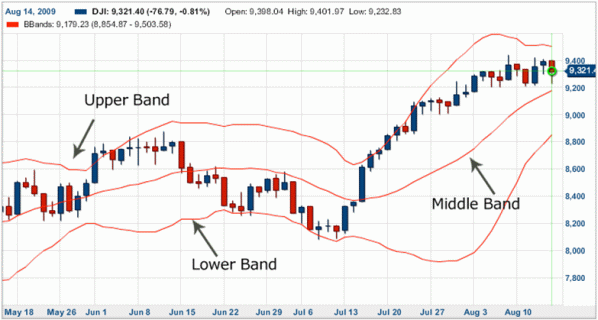Using Bollinger Band Bands To Gauge Trends
Post on: 16 Март, 2015 No Comment

Sunday, June 14, 2009
Using Bollinger Band Bands To Gauge Trends
Bollinger bands are one of the most popular technical indicators for traders in any financial market — stocks, bonds or foreign exchange (FX). Many traders use them primarily to determine overbought and oversold levels, selling when price touches the upper Bollinger band and buying when it hits the lower Bollinger band. In range-bound markets, this technique works well, as prices travel between the two bands like balls bouncing off the walls of a racquetball court.
Yet as John Bollinger was first to acknowledge, tags of the bands are just that — tags, not signals. A tag of the upper Bollinger band is not in and of itself a sell signal. A tag of the lower Bollinger band is not in and of itself a buy signal. Price often can and does walk the band. In those markets, traders who continuously try to sell the top or buy the bottom are faced with an excruciating series of stop-outs or worse, an ever-mounting floating loss as price moves further and further away from the original entry.
Perhaps a more useful way to trade with Bollinger bands is to use them to gauge trends. To understand why Bollinger bands may be a good tool for this task we first need to ask — what is a trend?
Trend as Deviance
One standard cliché in trading is that prices range 80% of the time. Like many clichés this one contains a good amount of truth since markets mostly consolidate as bulls and bears battle for supremacy. Market trends are rare, which is why trading them is not nearly as easy as it seems. Looking at price this way we can then define trend as deviation from the norm (range).
The Bollinger band formula consists of the following:
BOLU = Upper Bollinger Band
BOLD = Lower Bollinger Band
n = Smoothing Period
m = Number of Standard Deviations (SD)
SD = Standard Deviation over Last n Periods Typical Price (TP) = (HI + LO + CL) / 3
BOLU = MA(TP, n) + m * SD[TP, n]
BOLD = MA(TP, n) — m * SD[TP, n]
At the core, Bollinger bands measure deviation. This is the reason why they can be very helpful in diagnosing trend. By generating two sets of Bollinger bands — one set using the parameter of 1 standard deviation and the other using the typical setting of 2 standard deviation — we can look at price in a whole new way.
In the chart below we see that whenever price channels between the upper Bollinger bands +1 SD and +2 SD away from mean, the trend is up; therefore, we can define that channel as the buy zone. Conversely, if price channels within Bollinger bands 1 SD and 2 SD, it is in the sell zone. Finally, if price meanders between +1 SD band and 1 SD band, it is essentially in a neutral state, and we can say that it’s in no man’s land.
One of the other great advantages of Bollinger bands is that they adapt dynamically to price expanding and contracting as volatility increases and decreases. Therefore, the bands naturally widen and narrow in sync with price action, creating a very accurate trending envelope.
A Tool for Trend Traders and Faders














